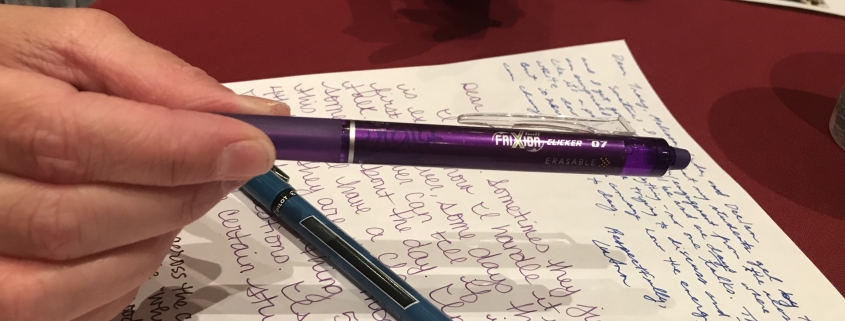We have all read the research about the benefits of reading fiction, but isn’t writing fiction a task for the few talented, creative people in the world who will make their living writing novels or children’s books?
Most every English language arts teacher has either heard this question or has posed this question. Many ELA teachers I know have made the decision to avoid or to cut writing fiction from their lesson plans due to the demands of their curriculum. Perhaps that’s a mistake. Are there benefits of writing fiction, and is there a place for teaching it in the curriculum? I decided to spend a little time researching this topic, which led me down a rabbit hole of fascinating scientific information!
In a 2014 NY Times article “This is Your Brain on Writing,” writer Carl Zimmer shared a few insights from a neuroscience study of creative writing. Scientists mapped brain activities connected with creativity by asking people to participate in a series of writing tasks: copying text, brainstorming, and writing literary text. “For the first time, neuroscientists have used fMRI scanners to track the brain activity of both experienced and novice writers as they sat down — or, in this case, lay down — to turn out a piece of fiction.” fMRI is a process called functional magnetic resonance imaging in which a machine shows blood flow to various parts of the brain. “The inner workings of the professionally trained writers in the bunch, the scientists argue, showed some similarities to people who are skilled at other complex actions, like music or sports.”

This study indicates that practicing writing leads to activation of a part of the brain that “takes over” when actions become more automatic, which has implications for the regular practice of writing, certainly. What stood out to me more, though, was that both groups of writers showed brain activity during brainstorming and writing creatively that was not present when the subjects merely copied a piece of text. This is enough information for me as a teacher to prioritize creative writing in the classroom. Use this link if you are interested in the specific findings.
While Steven Pinker, the cognitive scientist who wrote How the Mind Works, was skeptical of the findings from this creative writing study, stating that creativity is difficult to define and measure, he does support the idea that fiction provides us with opportunities to learn. “Fictional narratives supply us with a mental catalogue of the fatal conundrums we might face someday and the outcome of strategies we could deploy in them” (543).
Current research on aging and age-related illnesses reveals powerful connections between storytelling and both mental and physical wellbeing, especially resilience. Writing stories or sharing stories verbally is used as a “healing modality” for the aging. (See The Effects of Storytelling on Happiness and Resilience in Older Adults and Narrative and identity in Alzheimer’s disease: A case study for more information.) Even digital storytelling makes the list as a potential therapy to promote healthy brain function in older adults.
While asking adults struggling with Alzheimer’s to remember their own life stories can cause stress and negative emotions, asking aging adults to create stories provides a positive, creative experience that exercises brain functions. Suggestions for creating a good story in the article Anti-Aging and Anti-Depressant Effects of Storytelling include advice such as adding strong details that show rather than tell, adding emotion and voice, and revealing character through details.
Sound familiar, teachers?
We know from research on reading that different parts of the brain are activated when readers connect with sensory details. A team of researchers from Emory University found that metaphors like “The singer had a velvet voice” activated sensory parts of the brain that phrases like “The singer had a pleasing voice” did not. They found “. . . there is evidence that just as the brain responds to depictions of smells and textures and movements as if they were the real thing, so it treats the interactions among fictional characters as something like real-life social encounters” (Paul 2012). Paul Zak’s research tells us that powerful stories cause the brain to release oxytocin and can cause us to empathize with characters, which can lead us to change our beliefs and behaviors.
So, scientific research points to clear benefits of writing (and reading) fiction, but what do some of the leading educators say?
Thomas Newkirk, author of Minds Made for Story, asserts that narrative is the “mother mode” to which all other modes of writing cling. He also claims “. . .narrative is the deep structure of all good sustained writing. All good writing’ (19). He goes on to say “. . . the narrative thread, the anecdote, the story of human interest, the apt metaphor are crucial tools in all forms of discourse . . .” (28). The entire book is a compelling argument supporting his title, our minds are made for story.
In their recent book 180 Days: Two Teachers and the Quest to Engage and Empower Adolescents, Kelly Gallagher and Penny Kittle ask the very question I started this blog with, why fiction? Their response: “The skills of narrative writing are the same in either genre [memoir or fiction] and many of our students love the opportunity to imagine and create. Writing fiction is neglected in middle and high school. Each year we see students deeply engage in writing when given the opportunity to imagine a setting, its characters, and a conflict” (139). For their lesson ideas, see Chapter 6.
My personal conclusions:
If storytelling, both creating stories and sharing stories, is so powerful that it stimulates multiple parts of the brain in ways that help keep our mental capacity sharp, this alone tells me all teachers should take note. Add this to the facts that fiction can lead people to empathize and take positive action, can help engage students in ways writing purely informational texts cannot, and can provide a structural base for all other modes of writing, then devoting time in the curriculum to writing fiction certainly seems worthwhile to me.
For more information, see the following articles.
Researching the Brian of Writers
The Neuroscience of Your Brain on Fiction
Why You Are Wrong If You Think Creative Writing Is a Frivolous Waste of Time
Hasson brings real life into the lab to examine cognitive processing
Writing Can Help Injuries Heal Faster
Can Fiction and Academic Writing Help Each Other?







